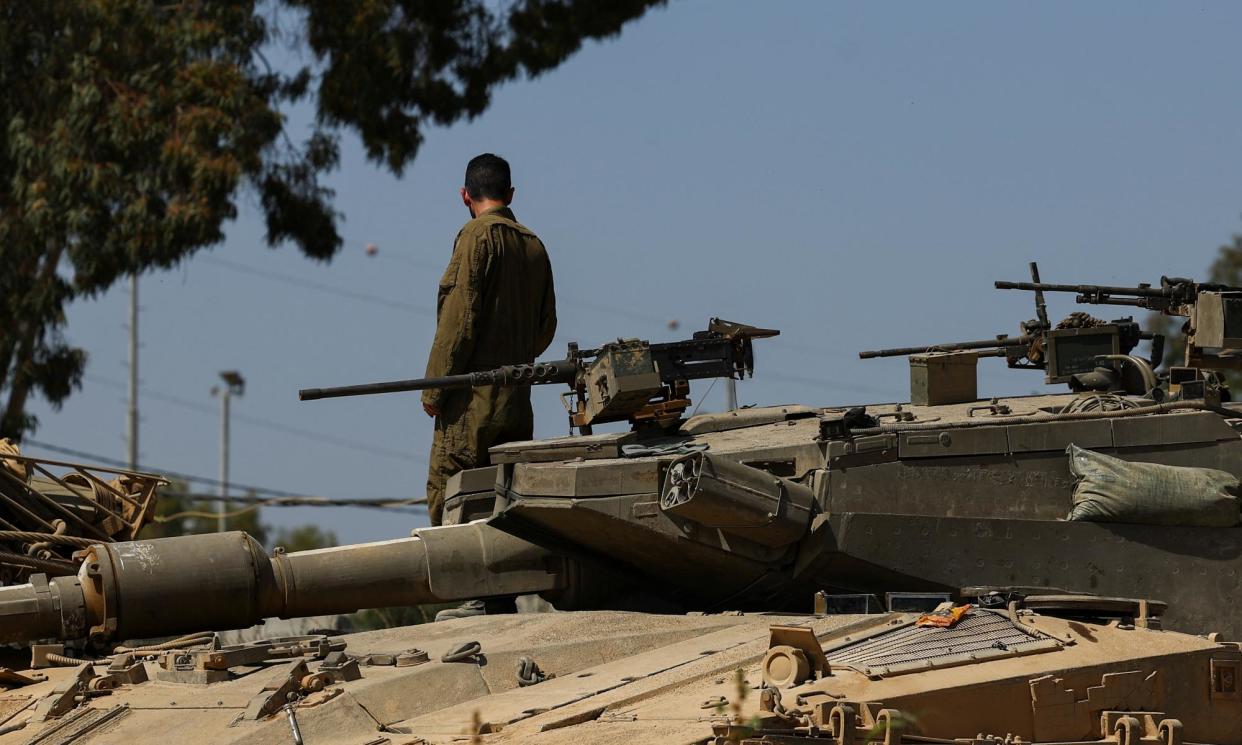Israel’s rules of engagement seem looser than ever – if they are followed at all

The killing of seven foreign aid workers by the Israel Defense Forces in Gaza has once again raised serious questions about the IDF’s opaque and highly permissive rules of engagement, whether those rules are enforced, and how willing it is to investigate breaches.
Put simply, rules of engagement define how and in what circumstances it is permissible to use force, including lethal violence, during operations, and at what potential risk to civilians.
Even though Israel has promised a full and professional investigation into the killing of the aid workers from World Central Kitchen, the reality is that human rights organisations, inside Israel and beyond, have long raised questions about the IDF’s rules, amid allegations that the ones that do exist are being ignored by soldiers and commanders on the ground.
Related: ‘The machine did it coldly’: Israel used AI to identify 37,000 Hamas targets
While the issue is complicated by the fact the IDF’s rules of engagement are classified, reporting by the Israeli media and human rights organisations suggests an exceptionally high tolerance level for civilian casualties in the current conflict.
While soldiers on the ground are theoretically advised when they are allowed to use lethal force against nearby individuals on the basis of loosely defined risk posed by proximity, the more serious issue in terms of civilian casualties has been the application of so-called “operational modes”.
In previous conflicts, the IDF is believed to have broadly applied three levels of operational mode – from most restrictive to most permissive – which specify an acceptable level of damage to structures, and a permissible ratio of civilian casualties, in relation to the value of the target.
In the current war, observers suggest, rules that were already permissive in previous conflicts in Gaza have been loosened further still, as evidenced by the number of civilian casualties in high-profile strikes.
In one highly controversial incident in particular – an Israeli airstrike on Jabalia refugee camp last October, which the IDF said had targeted a Hamas battalion commander – the monitoring group Airwars identified well over 100 civilians killed in the attack.
Estimates of the proportion of women and children killed in the current conflict in comparison with previous Gaza wars tell their own story. In previous outbreaks of fighting, women and children have made up roughly a third of fatalities. In this conflict, the proportion appears to be between 60% and 70% – suggesting a far higher civilian-combatant ratio, even allowing for overreporting by the Hamas-controlled ministry of health.
“From our understanding, looking at the IDF’s behaviour and targeting, it makes it clear that the tolerance for civilian [casualties] is systematically far worse than in past wars,” said Yehuda Shaul, co-founder of the thinktank Ofek, who has researched Israeli military’s targeting policies.
You don’t strike a de-conflicted convoy repeatedly, hitting three vehicles over a kilometre of road, by accident
Jeremy Konyndyk, Refugees International
The sheer number of strikes – sometimes in the hundreds – that have occurred on some days during the six-month war also raises questions of how detailed the intelligence behind them can be, not least given persistent concerns over the Israeli use of AI to identify targets.
What that tolerance means in practical terms was described in an investigation by the Israeli newspaper Haaretz over the weekend, which described Gaza as a network of lethal free-fire zones – whose boundaries are invisible to Palestinians – where those killed, civilian or otherwise, are defined by default as being “terrorists”.
More serious still are the allegations that have emerged in the immediate aftermath of the killing of the seven aid workers: that even within that highly permissive context, some units and commanders are essentially doing what they want when it comes to targeting.
Contradicting the IDF’s claims that the strike on the aid convoy was a simple case of “misidentification”, an unnamed officer in the IDF’s intelligence branch told Israeli media that the IDF command “knows exactly what the cause of the attack was: in Gaza, everyone does as he pleases”.
“It has no connection to coordination [with aid organisations],” the source continued. “You can set up another 20 administrations or war rooms, but if someone doesn’t decide to put an end to the conduct of some of the troops inside Gaza, we’ll see more incidents like this.”
That view was echoed by Jeremy Konyndyk, the president of Refugees International and a former official in the Obama administration, on social media in the immediate aftermath of the World Central Kitchen killings: “You don’t strike a de-conflicted convoy repeatedly, hitting three vehicles in succession over the course of a kilometre of road, by accident. You do that by fostering a military culture that treats Gaza as a free-fire zone with total impunity for gross attacks on civilians.”
As Joe Biden has made clear, the killing of the seven aid workers was not an isolated incident in a conflict where, by the UN’s estimate, 196 other humanitarian workers have been killed by Israel.
And while Israel’s defence minister, Yoav Gallant, and the IDF’s chief of staff, Herzl Halevi, have promised a comprehensive investigation of the incident, few familiar with previous IDF investigations have much confidence that it will be either full or transparent.
Since at least the time of second intifada, human rights groups have repeatedly highlighted what they say has been the failure of the IDF to adequately investigate incidents involving civilian deaths.
•Guardian Newsroom: Crisis in the Middle East
On Tuesday 30 April, 7-8.15pm GMT, join Devika Bhat, Peter Beaumont, Emma Graham-Harrison and Ghaith Abdul-Ahad as they discuss the fast-developing crisis in the Middle East. Book tickets here or at theguardian.live


